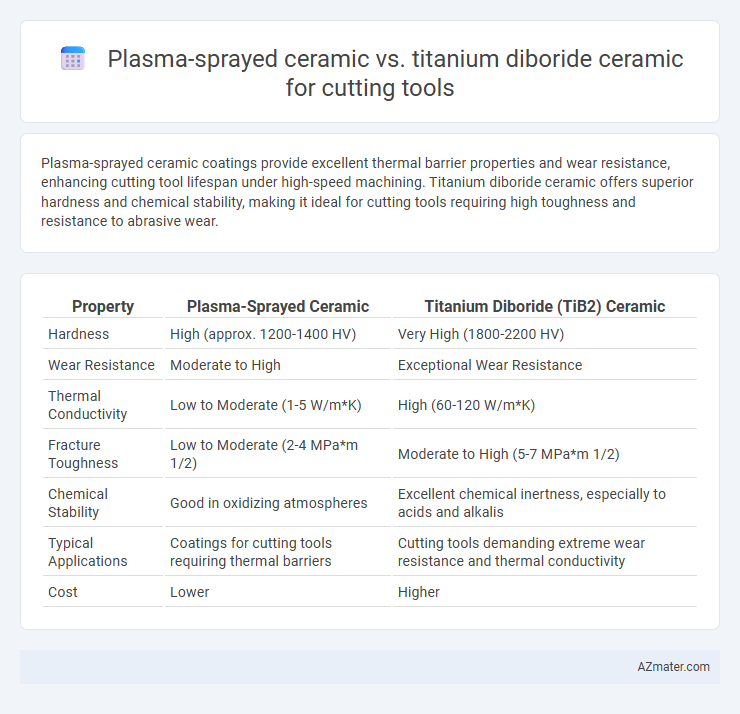Plasma-sprayed ceramic coatings provide excellent thermal barrier properties and wear resistance, enhancing cutting tool lifespan under high-speed machining. Titanium diboride ceramic offers superior hardness and chemical stability, making it ideal for cutting tools requiring high toughness and resistance to abrasive wear.
Table of Comparison
| Property | Plasma-Sprayed Ceramic | Titanium Diboride (TiB2) Ceramic |
|---|---|---|
| Hardness | High (approx. 1200-1400 HV) | Very High (1800-2200 HV) |
| Wear Resistance | Moderate to High | Exceptional Wear Resistance |
| Thermal Conductivity | Low to Moderate (1-5 W/m*K) | High (60-120 W/m*K) |
| Fracture Toughness | Low to Moderate (2-4 MPa*m 1/2) | Moderate to High (5-7 MPa*m 1/2) |
| Chemical Stability | Good in oxidizing atmospheres | Excellent chemical inertness, especially to acids and alkalis |
| Typical Applications | Coatings for cutting tools requiring thermal barriers | Cutting tools demanding extreme wear resistance and thermal conductivity |
| Cost | Lower | Higher |
Introduction to Advanced Cutting Tool Materials
Plasma-sprayed ceramic coatings enhance cutting tool performance by providing superior wear resistance and thermal stability compared to conventional materials. Titanium diboride (TiB2) ceramics exhibit exceptional hardness, high melting points, and excellent chemical inertness, making them ideal for aggressive machining applications. The comparison highlights TiB2's superior toughness and oxidation resistance, whereas plasma-sprayed ceramics offer versatility through tailored microstructures for optimized tool life.
Overview of Plasma-Sprayed Ceramic Coatings
Plasma-sprayed ceramic coatings, commonly applied using techniques such as atmospheric plasma spraying (APS), offer superior wear resistance and thermal stability essential for cutting tools operating under extreme conditions. These coatings, typically composed of materials like alumina or zirconia, provide excellent hardness and oxidation resistance but may exhibit lower fracture toughness compared to titanium diboride ceramics. In contrast, titanium diboride coatings, produced by advanced methods including physical vapor deposition (PVD) or chemical vapor deposition (CVD), deliver exceptional hardness and chemical inertness, enhancing tool life in high-speed machining of abrasive materials.
Introduction to Titanium Diboride Ceramic
Titanium diboride ceramic exhibits exceptional hardness, high melting point, and excellent wear resistance, making it ideal for cutting tool applications requiring durability and precision. Compared to plasma-sprayed ceramics, titanium diboride offers superior thermal conductivity and chemical stability, leading to increased tool life under high-temperature machining conditions. Its unique combination of mechanical strength and oxidation resistance enhances performance in cutting operations involving hardened steels and abrasive materials.
Material Properties Comparison: Hardness and Toughness
Plasma-sprayed ceramic coatings typically exhibit high hardness values around 1600-1800 HV, providing excellent wear resistance, while Titanium diboride (TiB2) ceramic displays superior hardness, often exceeding 3000 HV, enhancing cutting edge durability. However, TiB2 ceramic offers higher toughness and fracture resistance compared to brittle plasma-sprayed ceramics, reducing chipping during cutting operations. The combination of TiB2's exceptional hardness and toughness makes it a preferred material for cutting tools requiring both durability and resistance to mechanical stresses.
Wear Resistance: Plasma-Sprayed vs Titanium Diboride Ceramics
Plasma-sprayed ceramics exhibit excellent wear resistance due to their dense microstructure and strong adhesion to substrates, making them suitable for abrasive cutting applications. Titanium diboride ceramics outperform plasma-sprayed coatings with superior hardness (Hv up to 3200) and high fracture toughness (up to 7 MPa*m^0.5), resulting in enhanced resistance to wear and thermal degradation during high-speed machining. The combination of chemical inertness and mechanical durability in titanium diboride ceramics offers longer tool life compared to plasma-sprayed ceramic coatings under severe cutting conditions.
Thermal Stability and Heat Resistance Analysis
Plasma-sprayed ceramic coatings exhibit excellent thermal stability withstanding temperatures up to 1200degC, while titanium diboride (TiB2) ceramics offer superior heat resistance, maintaining structural integrity beyond 1500degC. TiB2's high melting point (approximately 2970degC) and exceptional thermal conductivity enable efficient heat dissipation, reducing tool wear during high-speed cutting. In contrast, plasma-sprayed ceramic layers provide enhanced adhesion and toughness but may experience microcracking under prolonged thermal cycling compared to the more resilient TiB2 ceramics.
Edge Retention and Tool Life Performance
Plasma-sprayed ceramic coatings on cutting tools offer enhanced edge retention due to their superior hardness and thermal stability compared to conventional coatings. Titanium diboride (TiB2) ceramics provide exceptional wear resistance and chemical inertness, significantly improving tool life performance under high-speed cutting conditions. TiB2's lower friction coefficient also reduces tool wear, making it a preferred choice for applications requiring prolonged tool durability and consistent edge sharpness.
Cost Efficiency and Manufacturing Considerations
Plasma-sprayed ceramic coatings offer cost efficiency through lower raw material expenses and faster application rates, making them suitable for large-scale production of cutting tools. Titanium diboride ceramics, despite higher material and processing costs due to specialized sintering techniques, provide exceptional hardness and wear resistance that extend tool lifespan and reduce frequency of replacement. Manufacturing considerations favor plasma spraying for versatile, complex tool geometries, while titanium diboride requires precision machining and controlled environments, impacting overall production throughput and cost.
Applications in Industry: Suitability and Limitations
Plasma-sprayed ceramics offer excellent thermal stability and wear resistance, making them suitable for high-speed cutting tools in automotive and aerospace industries where heat generation is significant. Titanium diboride ceramic exhibits superior hardness and toughness, ideal for abrasive machining and cutting of hard materials such as cast iron, composites, and superalloys, commonly used in heavy-duty metal cutting and mining applications. Limitations include plasma-sprayed coatings' potential for porosity and delamination under extreme mechanical stress, while titanium diboride's brittleness restricts its use in impact-prone environments.
Conclusion: Choosing the Optimal Ceramic for Cutting Tools
Plasma-sprayed ceramics offer superior thermal resistance and toughness, making them ideal for high-speed cutting operations involving abrasive materials. Titanium diboride ceramic excels in hardness and wear resistance, providing exceptional durability against heavy-duty machining and cutting of hard metals. Selecting the optimal ceramic depends on balancing thermal stability and hardness requirements specific to the cutting application, with plasma-sprayed ceramics favored for heat-intensive tasks and titanium diboride preferred for enhancing tool lifespan under extreme wear conditions.

Infographic: Plasma-sprayed ceramic vs Titanium diboride ceramic for Cutting tool
 azmater.com
azmater.com